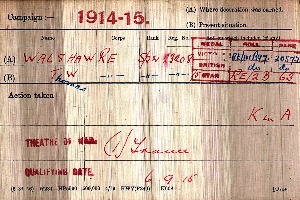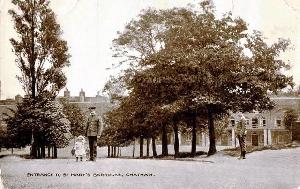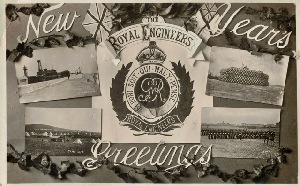Illustrated Chronicle

Medal Index Card

© Entrance to St Mary's Barracks at Chatham.
Newcastle Journal Thursday 8th August 1918

© Royal Engineers Postcard
Thomas William Walshaw was born on the 26th September 1892, at 36 Alexander Terrace, Sunderland, the eldest child of Thomas Frederick (born 1870 at Upper Charlton Street, Marylebone, London, died 5th April 1938), and Laura Constance Walshaw, (born 21st June 1868 in Durham, died in March 1950), who married in Millfield, Sunderland on the 30th April 1892.
Traced through the Census returns with his family, in 1911 aged 18 years Thomas is working at the iron foundry.
Thomas was one of six surviving children (all born in Sunderland) and his siblings were George Frederick, born born 2nd August 1897, Ann Adelaide (born 9th June 1894), Laura Constance (born July 1895) Isabel Cape (born 15th November 1899) and Edith Maud (born 14th July 1906). Sadly the coupleís twins John Cape and Charlotte Elliott did not survive, born in April 1902 they both died only days old.
The family can be traced through the Census returns and are found at 87 William Street in Pallion in 1901, and in the following Census living in four rooms at 82 Devonshire Street in Sunderland in 1911.
Unfortunately his military papers have not survived, so the exact details of his service cannot be ascertained. However Thomas is known to have enlisted in Sunderland and served as a Sapper with the Royal Engineers, 401st Field Company, with service number 23208 and he arrived in France on the 6th September 1915.
The Field Company of the Royal Engineers provided technical skill and knowledge to support the Division. The War Diary for the 401st Field Company details much of the work they were involved in, and many kinds of trades were required and represented including blacksmiths, bricklayers, carpenters, draughtsmen, surveyors, wheelwrights, masons, engine drivers, painters and plumbers etc. They were attached to the fighting portions of the Divisions, and often saw action and took part in the fighting.
At the start of the Great War, the men who were needed to bring the Field Companies up to strength came from the Royal Engineers Training Depot at Aldershot (mounted men) and the Royal Engineers Reserve Battalion and Depot Companies at Chatham (dismounted men). Each infantry Division included two Field Companies but it was soon realised a third Field Company per Division was urgently required and arrangements were made for eight Territorial Field Companies to fill these much-needed places in the first eight Divisions. The Companies were given numbers in 1917.
Thomas arrived in France in September 1915, his Company was now allocated to the 2nd (Highland) Field Company TF, 7th Division and in September the 7th Division were in action at the Battle of Loos, 25th to the 28th September.
The 401st Field Company were subsequently allocated to the 51st Division from January 1916 and the Division fought in The Battles of The Somme in 1916, The Arras Offensive, Third Battles of The Ypres and the Cambrai Operations in 1917, and The First Battles of the Somme, Battles of the Lys, Battles of the Marne, Second Battle of Arras and the Final Advance in Picardy in 1918.
Newspaper records show that Thomas was suffering from an illness in 1917, but without his military records unfortunately it has not been possible to find any further details. The Sunderland Daily Echo and Shipping Gazette 13/09/1917 reported that Sapper T. W. Walshaw, R.E., the eldest son of Detective Walshaw, is making a good recovery from his severe illness, and expects to rejoin his company in a week or so.
Thomas was killed on the 23rd July 1918, when the Division were fighting in the Battle of Tardenois (15 July to 6th August 1918) one of the phases of the Battles of the Marne. He was 25 years old. Following an enemy attack south west of Reims, an area that was being held by the French army, Sir Douglas Haig agreed to send a British Corps consisting of 15th (Scottish), 34th, 51st (Highland) and 62nd (2nd West Riding) Divisions. The 51st and 62nd Divisions were involved in heavy fighting in the valley of the Ardre, at Marfaux and Mont de Bligny, the action now known as The Battle of the Tardenois.
Referring to the War Diary, at the beginning of July 1918 the 401st Field Company were in billets at Ecurie, but by 21st they had moved into bivouacs in Sarbruge Wood, south west of Nanteuil. The next day they moved forward to work with small parties of infantry operating in BOIS DE COUTRON against German machine gun nests. The Royal Engineers were to clear behind the infantry to enable them to maintain communication; Orders were received for the Royal Engineers to remain up and assist the infantry in an attack the following morning. No 3 & 4 sections were fairly heavily shelled while waiting.
On the 23rd at 6am, the 152nd Infantry Brigade attacked north of the Bois De Coutron, their objectives were ESPILLY and BOIS DíAULNAY. The Company was working with the 154th Infantry Brigade who was to push forward on their left in the wood at the same time without a barrage. 401st Field Company was employed in 4 parties with the 7th Argyle & Southern Highlanders, the 8th Royal Scots and the 4th Gordon Highlanders. Their work was to make narrow clearings behind the infantry parallel to the front line as the infantry advanced and also to clear pathways in the direction of the advance so that the infantry could keep direction and maintain communication in the wood. The wood (BOIS DE COUTRON) here was very thick and almost impassable.Hostile barrage was very heavy; also some shell of our own barrage fell short on our own troops. The heavy hostile shelling continued throughout the day, no advance was made on the 154th Infantry Brigade front. 152nd Infantry Brigade took the BOIS DíSULNSY but was held up short of ESPILLY. Casualties; Other ranks 1 killed, 11 wounded. 1 wounded (gas), 1 missing, 1 missing believed wounded, 1 wounded at duty.
Thomas had left a will, in the event of his death all his effects were left to his wife Mrs. Alice Grace Walshaw of 26 Victoria Road, Luton, Chatham, Kent.
Newcastle Journal dated 8th August 1918KILLED Sapper T. W. Walshaw (25), R.E. (father, Detective T. F. Walshaw 13, Guisborough Street), on July 23rd. Sapper Walshaw had been at the front since March 1915. His younger brother was killed in September 1916.
Thomas and his wife Alice Grace (nee Morris) had two children, Thomas William born 29th October 1915 in Sunderland and also Leonard George born 17th September 1918 in Chatham. Tragically Thomas William never saw his second son, as Leonard was born after his father was killed. Alice is found in the 1939 Register living at 71 Magpie Hall Road in Chatham, Kent; She eventually remarried in 1951 to William Sym.
Thomas was awarded the 1914/15 Star, the British War Medal and the Victory Medal for his services in the Great War.
Research : Jean Atkinsom
Thomas William Walshaw is remembered at Sunderland in S140.048 Part 07.

